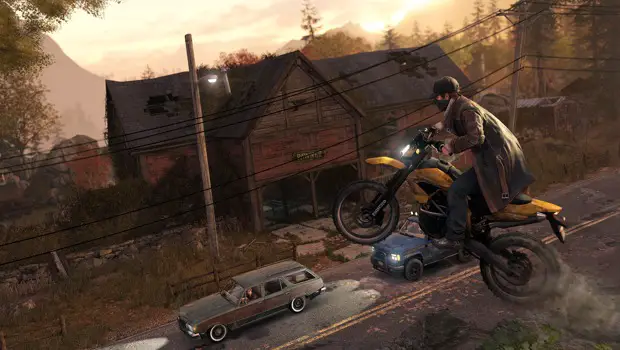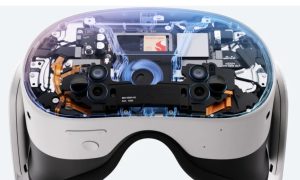Hacking is, and has always been, a passion of mine. From the early days of BBS and phone phreaking to the script kiddie days of NMAP, Super-Scan, and NESSUS, as long as people have been writing code, guys like me have lived just to break it. When Watch Dogs was revealed at E3 2012, it didn’t take much to figure out what their inspiration was – take a look around you. We live in a digital age, powered by progressively more powerful computers that fit in the palm of our hands. We buy things on eBay with these devices, we talk with our loved ones, and we even make bank transactions on them. Our lives have been distilled to its purest digital form – we are, without equivocation, projecting a digital version of our analog selves for anyone with the right tools to see. Let that sink in and then ask yourself – if you had the power to control all of those digital personas, what would you do with that power?
** First 5 minutes of the game spoiler**
Watch Dogs takes place in a reimagined Chicago. After a tragic accident takes the life of his young niece, a very broken Aiden Pierce begins to dig into the suspicious circumstances that ended her life. As his past rises like a shadow behind him, Aiden is now on a hunt to find out who was behind the hit, but to get to the bottom of this conspiracy, Aiden will need information – lots of it.
End spoiler **

First, let’s just stop the “graphic downgrade” bullshit. I’ve played it for four hours – there is no graphical downgrade going on here. There is a little bit of pop-in with vehicles on the road, but hopefully that’ll be ironed out in the move from debug to retail. I also spotted a few framerate hitches, but again I’m not dealing with a final product. If you want guarantees of high resolution and a rock solid framerate, buy an NVidia Titan card and a PC to put it in and stop complaining. Watch Dogs is plenty pretty, but there is so much to talk about beyond such surface concerns.
Mobile data mastery
Obviously Aiden’s smartphone is the conduit through which he unleashes his digital wrath, so that device features prominently. At any point you can press up on the D-Pad to bring up a transparent projection of your phone. This serves as the hub by which you’ll access all information in the game. Your map, any activities you might discover, information you’ve stumbled upon or extracted through profiling, the progression wheel, calling in vehicles, and much more. It’s also your window into the digital soul of passers-by. Pressing square on the controller activates your profiler. This application pulls information like a magnet, exposing crucial data on anyone near you. Their name, some critical fact about their past, their current financial standing, and more are at your fingertips. People with insecure banking applications on their phones can be hacked, their accounts drained at your next visit to an ATM. As I played through my four hours of hands-on time with the game I was shocked by something unconscious that happened thanks to these little snippets of information – I cared about NPCs.

We’ve all played Grand Theft Auto or other sandbox games, haphazardly throwing people from their vehicles. In Watch Dogs I found that I started to really be selective, not only about my vehicle choice, but also about the owner. When you yank somebody out of their car and you quickly spot “volunteers for a local ministry” or “recently diagnosed with cancer” you really think twice about your actions. Of course, when you see “Killed a dolphin” you are more tempted to put a bullet in them, because honestly – who does that? The exposed digital identities of these random strangers humanizes them in a way that may surprise you. Your phone has another use beyond hacking – it also exposes the hardlines that reveal how circuits and alarms are wired. You can’t always use remote viewers and hacking to reach your objective, so sometimes it requires a bit of tracing and some legwork. Augmented Reality is also guided through your phone. Cash Run, as an example, is a free-running parkour game where you collect coins as fast as you can while avoiding red skulls in an 8-bit augmented overlay to the real world. NVZN is an AR overlay that puts an alien skin on NPCs, allowing you to interact with virtual graffiti and “pew-pew-pew” with your phone to destroy the imaginary invaders before the timer runs out. It’s the “Digital Trip” that’ll blow your mind. We’ve all seen the ‘leaked’ screenshot with the giant mechanical spider, leading people to some very crazy speculation about what sort of missions are in Watch Dogs. No, these aren’t nefarious government cyber-enforcers that you’ll battle in the game – it’s an augmented reality game called Spider Tank. This VR world lets you play as a heavily armored military spider tank, providing a fun distraction from the open world sandbox. You are given rolling objectives of progressively higher difficulty like killing a certain amount of cops, blowing up a helicopter, and generally causing mayhem. You earn points here, allowing you to upgrade your spider-tank with things like faster reloads, higher damage rounds, etc. for the next time you play. There is certainly plenty to do, but sometimes you need to blow off a little steam – this provides exactly that, and is an awesome break from reality. Besides, who doesn’t want to drive a giant spider tank?!

Hack the planet
Aiden isn’t going to take down his foes with AR and profiling – actions in the real world are required. In the beginning, Aiden has very few applications and a small battery in his phone. This allows him to take very basic actions up to three times before waiting for a recharge. Some actions, hacking streetlights for instance, cost one charge, whereas causing a steam pipe to rupture costs you two. On a high speed chase, you can quickly find yourself out of charge on your phone, so conservation and using the right distraction at the right moment becomes key. Hacking the ctOS, the all-encompassing city-wide software that manages the reinvisioned smart city of Chicago, is where the rubber meets the road. There are 16 ctOS towers scattered throughout the city that allow Aiden to uncover all of the activities in that section of Chicago. It also highlights the unique digital parkour in Watch Dogs. Aiden isn’t a professional assassin, so he uses cameras and digital hopping to climb things. Bouncing from camera to camera, you’ll hack from device to device up to a nearby tower, unlocking gates and locked doors along the way. Using a more real-world set of climbing parkour skills I was able to reach the tower and install a backdoor into the ctOS network. At this point I could see all of the activities available for the district These are essentially the Watch Dogs equivalent of a sync point in Assassin’s Creed. When you decide to tackle a ctOS data center, things get very interesting. These locations are often heavily fortified with armed guards, strong security protocols, and contain vast amounts of information that Aiden will need to resolve the main story elements.

Hacking a data center presents the player with a ‘turn the pipes to enable flow’ style puzzle system. These start out simply enough, but eventually you’ll see pipes (90 degree, T-intersections, etc.) that when touched trigger alarm countdown timers. There are often multiple layers of security, and all of your hacking is in real time, allowing guards to sneak up on you as you remain jacked into cyberspace. A little planning (or liberal application of the asp – an extensible steel tactical baton that collapses for ease of concealment) goes a long way. Once you breach the secure data center you can take control of ctOS-enabled objects like blockers, lights, and other electronic items in the area, but the racks often contain something far more interesting. People in the real world are often dazzled by the convenience of their phones without thought of how their precious moments are stored. The people in Watch Dogs suffer a similar affliction, and their memories, secrets, and horrors are stored in the data vaults mentioned above. These moments are digital curiosities and entirely optional, ranging from watching a couple play a motion-enabled exercise game, an angry husband thinking about murdering his wife, or somebody using virtual glasses (*cough* Google Glass *cough*) to fly a drone around to spy on his neighbors. If you are getting a data aggregation pre-crime prediction system idea in your head, you are getting the right vibe. Watch Dogs’ Chicago is spying on her citizens, aggregating data, and commoditizing the information. The implications and parallels to the real world are interesting and rather shocking to contemplate. Obviously with my background in Network Engineering and hacking, I was very interested in the creative process behind the authenticity of the breach methods in Watch Dogs. I sat down with Thomas Geffroyd, Content Director, to have a chat about the lengths they went to to make this the most realistic representation of hacking we’ve seen in a game to date.
[jwplayer mediaid=”83349″]
A peek behind the curtain
** Very Minor Chapter 2 spoilers **
After we got through the first story mission the team jumped us to the second chapter with quite a few more unlocked skills. A fellow fixer named Jordi, who always seems to have some sort of intricate plot on how he can make use of the dead bodies he’s recently ‘acquired’, is meeting up with us in the back of an ice cream truck. Giving us a sticky bomb, he sets us up with some intel on a local scumbag named “Bedbug” – a lieutenant for a group of thugs called the Viceroys. Clearly Aiden knows only the most top echelon of Chicago citizens. Showing up to the meeting area early, we were given two minutes to create an ambush and find a safe vantage point. Using the crafting system I quickly cobbled together some IEDs and placed them strategically for maximum damage. Climbing up into the overhead scaffolding and taking cover, I utilized the nearby cameras for a birds eye view. As the Viceroy crew rolled in and stepped out of their car, I detonated the sticks of dynamite to cut their forces in half. Using distractions to push them forward and lures to funnel them into chokepoints where other explosives awaited them. In the end, I cut down their entire force having never fired a shot.

With the rest of his crew dead, the last Viceroy made a break for it. Chasing him down before he could escape and warn “Bedbug”, I put the second half of my plan in motion. Sneaking up on Tyrone “Bedbug” Hayes, I used a little bit of digital wizardry to make the electronic world around him go completely crazy. Like a digital ghost, I haunted him until he agreed to be my eyes and ears as we spy on a man named “Iraq”. While we only got to experience three of the main story missions, if they are any indication of the remaining 33 of them, we are in for an awesome ride. I got to sit down with Kevin Shortt, Lead Story Designer for a 19 minute chat about the story elements in Watch Dogs. You can check out that interview below.
[jwplayer mediaid=”83348″]
** End Very Minor Chapter 2 spoilers **
L33T skillz
The skills tree allows you to greatly expand your ability to hack items in the world. These start simply enough with gates and garage doors, but quickly you’ll be hacking traffic lights, bollards (blockers), road spikes that could pop your tires (or that of your pursuers), ATMs, and more. Additionally you have a whole host of combat upgrades such as being able to rapidly reload, reduced weapon recoil, greater skill when using the asp, or combat focus skills which slow down time momentarily for a more aimed takedown. Crafting is a smaller but far more critical tier in the upgrade system. You can create lures that can be used to draw enemies to or away from you, explosives, comms jamming, and the incredibly effective blackout which creates targeted chaos through a city-wide blackout. There isn’t a minigame for crafting; simply having the right ingredients, skills, and a quick tap on the triangle key. Driving skills are important for when you eventually grab the unwanted attention of the local PD. The skills in this tree allow you to disable car alarms, take less damage through collision (or cause more if you are an aggressive driver), and various other skills that’ll increase your chance at a hasty or stealthy escape.
A living world
There are plenty of things to do in the world of Watch Dogs. The first side-mission you’ll do outside the main mission set is to tail a potential victim and stop a crime. Doing this without killing the perpetrator increases your notoriety can be used to unlock things like anti-vehicle rounds, more nitrous for your cars, longer comms jams and more. These aren’t in any way necessary, but they are very helpful. Since you also earn more cash for doing things without making a mess, it behooves you to do things quietly. Citizens will also begin to turn a blind eye should you smash open a vehicle window or pull a gun in public. Lower notoriety will cause them to pull out their cell phone and call the police, helping them to triangulate your position more quickly. In fact, there are nearly 90 side missions, 36 main missions (the first of which took over an hour), 22 distraction missions like drinking, chess, and poker, 40 online contracts, 23 songs to steal from people’s phones, 100 city hotspots to find, 30 privacy invasion opportunities, 16 major ctOS centers to breach, a bevy of missing people and traffickers to stop, 40 fixer contracts, and on and on. This game is so much larger than we could have anticipated, and it is alive with things to do, just like a real world. To help bring the world alive, the team spent a great deal of time on motion capture. Each NPC has over 5,000 animation states, with Aiden adding another 4,000 or so to that mix. In all there are over 13,000 unique captured animations in the game, ensuring that you won’t see the same animation over and over. But what about the voice work?

Early in development the team decided to do something that would cost them a great deal of time and energy, but one that would alleviate a problem present in nearly every sandbox game to date – unique conversations. Voice repetition is a persistent issue, but in Watch Dogs there is exactly one opportunity to hear a conversation. Once a conversation has been heard it is marked as ‘destroyed’ by the game, ensuring you never hear it again – just like real life. When combined with the profiler data, it creates NPCs that become more alive than in any world we’ve explored before. Watch Dogs, not unlike The Elder Scrolls titles, the Saints Row series, or other sandbox titles, encourages you to tackle anything you’d like in any order you wish. I decided it was time to send a message to a local gang leader courtesy of a steel asp to the face. They had holed up in a nearby parking garage, patrolling and very well armed. I spotted a nearby scissor lift and climbed inside. A quick hack later and I was already hiding on the second floor. Hopping from one security cam to the next I surveyed my would-be victims, noting that several were veteran thugs or worse. I’m glad I didn’t walk through the front door or I might have gotten a buckshot salad for my efforts. Taking a moment to plan, I overloaded a nearby valve, striking one of the shooters unconscious. Using distractions like overloaded electrical panels, triggered car alarms, and a bit of stealth I isolated and cut down the entire floor of foes before they caught onto the now-empty patrol routes. Unfortunately I couldn’t get an eye into the second floor…until I spotted a guy with a camera phone. Remotely hacking the thug’s camera phone, I let him walk me up the stairwell and to the top floor, giving me a perfect view of my possible approach. A little patience went a long way, allowing me to tag all of the enemies I’d need to address without having to step foot in the area. I decided that it was time to really send a message when I spotted an enemy carrying a bomb with a remote timer. Knowing that my target could escape in the nearby van, I waited for the bomber to walk by the vehicle before I sent him to the great beyond. Using the ensuing chaos I quickly dispatched the remaining foes with a few well-placed headshots. You see, my mission was to send a message to their leader, so he was the only one I had to leave breathing. With a satisfying crunch I cracked him in the knee and then the skull, making this area a little safer for Chicago’s citizens.

Data theft with friends
In the past few years, Ubisoft has done a great job of creating new multiplayer experiences. Games like Assassin’s Creed have brought paranoia-inducing multiplayer, and Watch Dogs wants to expand on that idea. Optionally, you can open up your game to your friends which will allow them to pop in without your knowledge and attempt to sneak up and hack you. Remaining close to you without being detected for a period of time earns them experience, cash, and notoriety, but if you detect them you can shoot them dead. You can also set your game to require you to accept the incoming challenge, making this multiplayer mode inclusive instead of intrusive. Beyond this mode, there is also a mode called Online Decryption. Supporting from three to eight players, this mode unleashes two teams of fixers vying to capture a file. Both teams get access to firearms, weapons, and all of the hacking skills they have used in the single player game to attempt to thwart the other side. Picking up the file turns the game into a capture and hold type mode. Teammates that are nearby help decrypt the file faster, but if the enemy gets close they can wirelessly steal it from you. We played this mode across several maps, and every time it was a total blast. Whether we were racing down the rivers of Chicago in boats, shooting it out in the park with sniper rifles, or zipping through heavy traffic on motorcycles, the cat and mouse gameplay was pure fun.

Before we closed out the day we got to play the companion app that’ll ship concurrently with Watch Dogs. Unlike previous efforts, this is not a second-screen experience. Rather than move the minimap and HUD elements to a tablet, the team developed an adversarial experience pitting you against your friends. Your objective is to make it through ten checkpoints that add time with every successful pass, and their objective is to unleash the police and elements of the city to try to stop you. The beautiful part is that it is truly platform agnostic, allowing you to play this game with friends on Xbox One, PlayStation 4, Xbox 360, PlayStation 3, or PC all on the the same list. Check out this full walkthrough with Philippe Baude, Lead Game Designer for Watch Dogs’ companion app, ctOS mobile, to see it in action. He also takes a moment to show us the included editor that’ll ship with the app.
[jwplayer mediaid=”83346″]
Eager anticipation
If you’ve not figured it out thus far, I’m very excited about Watch Dogs. There is roughly a month worth of work ahead of the team still, and hopefully that’ll iron out the few minor framerate issues and occasional vehicle pop-in I saw on the PS4 debug builds. (It’s not uncommon to see those sorts of things evaporate in the move to a retail kit) Watch Dogs was the reason a great many people pre-ordered a next-gen console, and from what I’ve seen thus far, the anticipation is more than warranted. Watch Dogs is clearly divesting itself from its contemporaries by reinventing what it means to be stealthy. The digital parkour and hacking in this game is a such a fresh and new experience that there is literally nothing else like it. I can’t wait to explore this world further when it is released on May 27th on Xbox One, PlayStation 4, PC, Xbox 360, and PlayStation 3, with Wii U coming in the Fall.
Ron Burke is the Editor in Chief for Gaming Trend. Currently living in Fort Worth, Texas, Ron is an old-school gamer who enjoys CRPGs, action/adventure, platformers, music games, and has recently gotten into tabletop gaming.
Ron is also a fourth degree black belt, with a Master's rank in Matsumura Seito Shōrin-ryū, Moo Duk Kwan Tang Soo Do, Universal Tang Soo Do Alliance, and International Tang Soo Do Federation. He also holds ranks in several other styles in his search to be a well-rounded fighter.
Ron has been married to Gaming Trend Editor, Laura Burke, for 28 years. They have three dogs - Pazuzu (Irish Terrier), Atë, and Calliope (both Australian Kelpie/Pit Bull mixes), and an Axolotl named Dagon!

See below for our list of partners and affiliates:

























